Recombinant Human ANTXR1 protein(Met1-Ser321), hFc-tagged
| Cat.No. : | ANTXR1-7358H |
| Product Overview : | Recombinant Human ANTXR1 (NP_115584.1) (Met1-Ser321) was expressed in HEK293, fused with the Fc region of Human IgG1 at the C-terminus. |
- Specification
- Gene Information
- Related Products
- Case Study
- Application
- Download
| Species : | Human |
| Source : | HEK293 |
| Tag : | Fc |
| Protein Length : | 1-321 a.a. |
| Form : | Lyophilized from sterile PBS, pH 7.4. Normally 5 % - 8 % trehalose, mannitol and 0.01% Tween80 are added as protectants before lyophilization. |
| Molecular Mass : | The recombinant human ANTXR1 /Fc is a disulfide-linked homodimer. The reduced monomer comprises 530 amino acids and has a predicted molecular mass of 59.4 kDa. The apparent molecular mass of the protein is approximately 69 kDa in SDS-PAGE under reducing conditions. |
| Endotoxin : | < 1.0 EU per μg of the protein as determined by the LAL method |
| Purity : | > 90 % as determined by SDS-PAGE |
| Storage : | Samples are stable for up to twelve months from date of receipt at -20°C to -80°C. Store it under sterile conditions at -20°C to -80°C. It is recommended that the protein be aliquoted for optimal storage. Avoid repeated freeze-thaw cycles. |
| Reconstitution : | It is recommended that sterile water be added to the vial to prepare a stock solution of 0.2 ug/ul. Centrifuge the vial at 4°C before opening to recover the entire contents. |
| Gene Name | ANTXR1 anthrax toxin receptor 1 [ Homo sapiens ] |
| Official Symbol | ANTXR1 |
| Synonyms | ANTXR1; anthrax toxin receptor 1; anthrax toxin receptor; ATR; FLJ10601; FLJ21776; TEM8; tumor endothelial marker 8 precursor; 2310008J16Rik; 2810405N18Rik; tumor endothelial marker 8; FLJ11298; |
| Gene ID | 84168 |
| mRNA Refseq | NM_018153 |
| Protein Refseq | NP_060623 |
| MIM | 606410 |
| UniProt ID | Q9H6X2 |
| ◆ Recombinant Proteins | ||
| Antxr1-4985M | Recombinant Mouse Antxr1 protein, His-tagged | +Inquiry |
| ANTXR1-2117H | Recombinant Human ANTXR1 Protein, His-tagged | +Inquiry |
| ANTXR1-2342M | Recombinant Mouse ANTXR1 Protein (31-319 aa), His-tagged | +Inquiry |
| ANTXR1-0099H | Recombinant Human ANTXR1 Protein (Glu33-Lys321), C-His-tagged | +Inquiry |
| ANTXR1-2158H | Recombinant Human ANTXR1 Protein, MYC/DDK-tagged | +Inquiry |
| ◆ Cell & Tissue Lysates | ||
| ANTXR1-1463HCL | Recombinant Human ANTXR1 cell lysate | +Inquiry |
Case 1: Zhou C, et al. Cell Cycle. 2023
Gliomas are primary brain tumors that often come back and have poor outcomes. Our study focused on ANTXR1's role in glioma development and its impact on downstream pathways. ANTXR1 levels in glioma samples were analyzed through immunohistochemistry. By adjusting ANTXR1 in glioma cell lines using lentiviral transfection, we observed changes in mRNA, protein levels, and cell behavior via qRT-PCR and western blot. Further experiments involved tampering with the PI3K/AKT pathway in these cells. We found ANTXR1 was overexpressed in gliomas compared to normal brain tissues, and reducing ANTXR1 hindered glioma cell growth and movement while promoting cell death and interfering with mitosis. In vivo tests supported these observations. Activating the AKT pathway boosted the anti-tumor impact of knocking down ANTXR1, while inhibiting PI3K reduced the tumor-promoting effect of ANTXR1 overexpression. This indicates that ANTXR1 is key in driving glioma growth through the PI3K/AKT pathway.
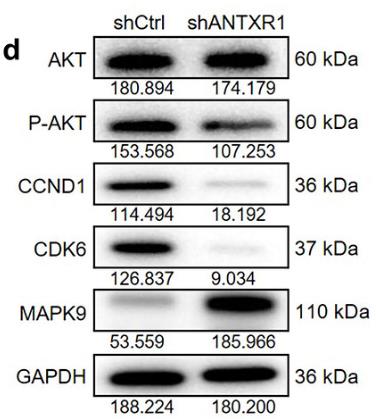
Fig1. A western blotting-based detection in the expression of proteins involved in MAPK9 signaling pathway in U251 cells.
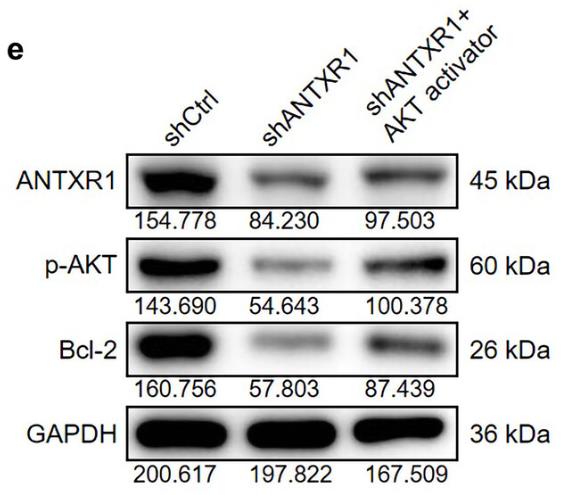
Fig2. The expression levels of ANTXR1, p-AKT and Bcl-2 in shCtrl, shANTXR1 and shANTXR1+AKT activator groups were detected by western blotting.
Case 2: Jin T, et al. Dis Markers. 2022
Making red blood cells, or erythropoiesis, is a pretty intricate process with lots of transcription factors and noncoding RNAs coming into play. ANTXR1, a type I transmembrane protein, teams up with anthrax toxin and influences red blood cell development by holding back γ-globin. In our studies using K562 and HUDEP-2 cell lines and cord blood CD34+ cells, we saw that higher ANTXR1 levels increase erythrocyte growth but hold back GATA1 and ALAS2 expression, slowing down cell differentiation and cutting down apoptosis. On the flip side, reducing ANTXR1 levels slowed growth but boosted GATA1 and ALAS2 expression, speeding up differentiation and maturing erythrocytes faster. Looks like ANTXR1 might play a role in hematopoietic cell behavior through the Wnt/β-catenin pathway, offering hints at potential therapies for blood-related issues.
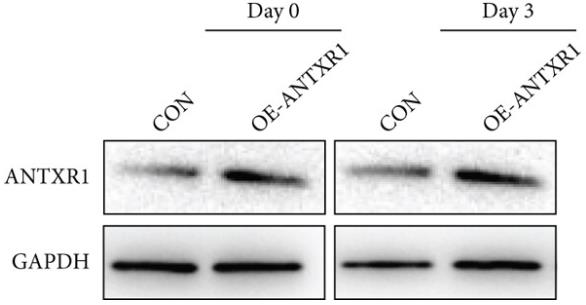
Fig1. ANTXR1 promotes erythroid cell proliferation and inhibits erythroid cell differentiation and apoptosis in K562 cells.
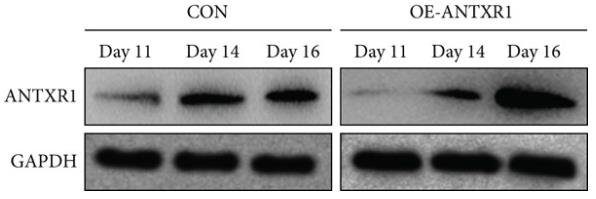
Fig2. ANTXR1 promotes erythroid cell proliferation and inhibits erythroid cell differentiation and apoptosis in cord blood CD34+ cells.
Recombinant Human ANTXR1 is quite versatile and finds applications in both research and industry. In cell biology, it helps regulate how cells stick, move, and maintain their extracellular matrix, essentially keeping things in balance. As a multipurpose protein, ANTXR1 plays a big role in cell attachment and movement by connecting with extracellular matrix proteins and the actin cytoskeleton, thus aiding cell structure and mobility. In cancer research, ANTXR1 is noteworthy for its involvement in the progression and development of various cancers, making it a valuable prognosis marker and a potential therapeutic target. In terms of viral infection studies, ANTXR1 acts as a receptor for anthrax protective antigen (PA), crucial for anthrax toxin entry into cells. Lastly, ANTXR1 influences angiogenesis, affecting how cultivated umbilical vein endothelial cells form blood vessels. These applications highlight its importance and potential across different scientific areas.
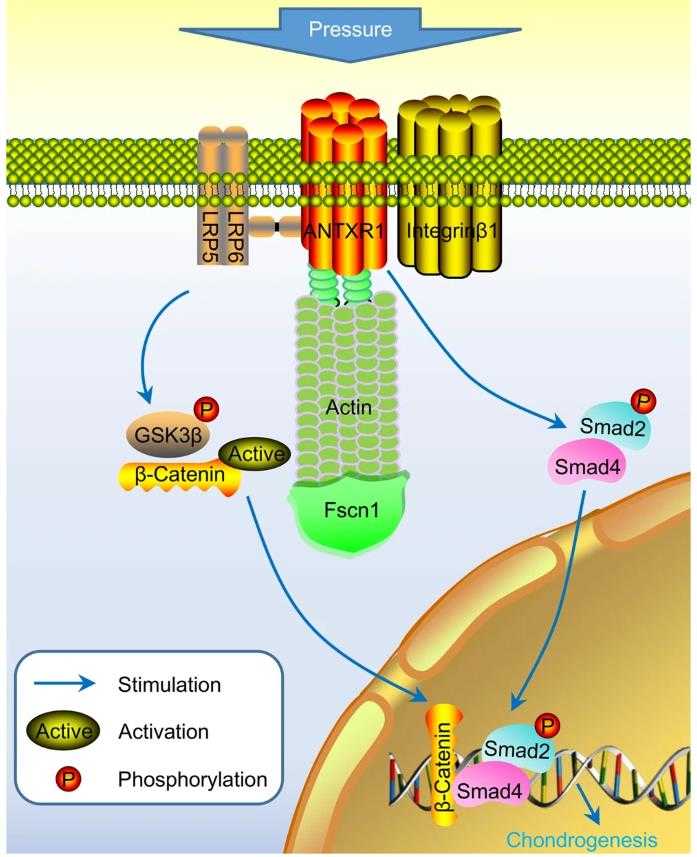
Fig1. Schematic drawing summarizing the possible role of ANTXR1 on chondrogenic effects in BMSC sheets under hydrostatic pressure. (Baixiang Cheng, 2019)
Not For Human Consumption!
Inquiry
- Reviews
- Q&As
Ask a Question for All ANTXR1 Products
Required fields are marked with *
My Review for All ANTXR1 Products
Required fields are marked with *
Inquiry Basket


